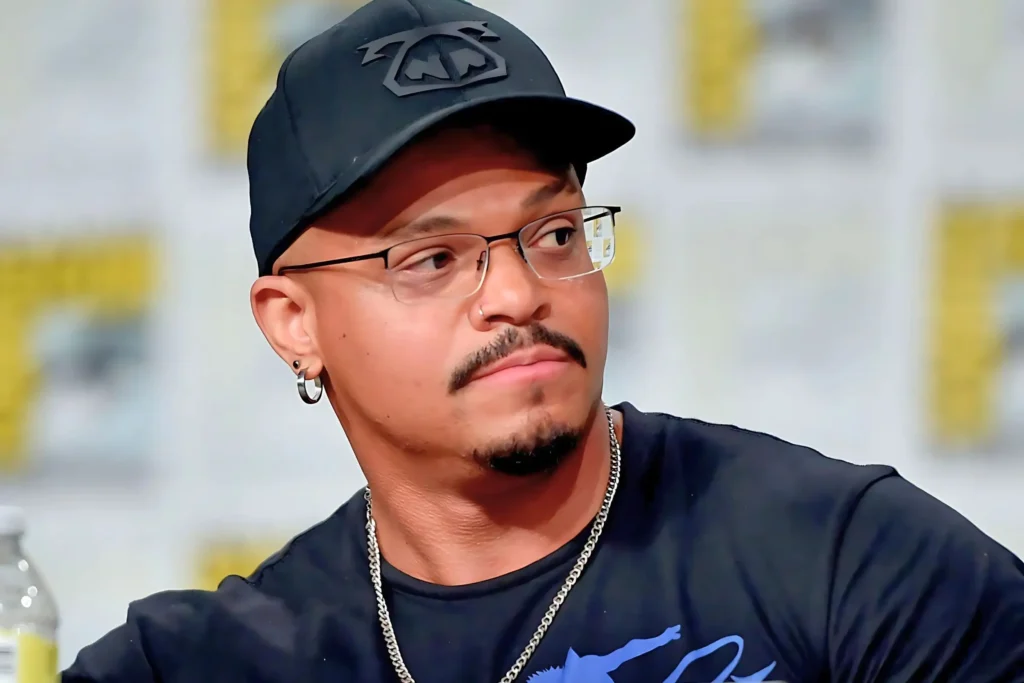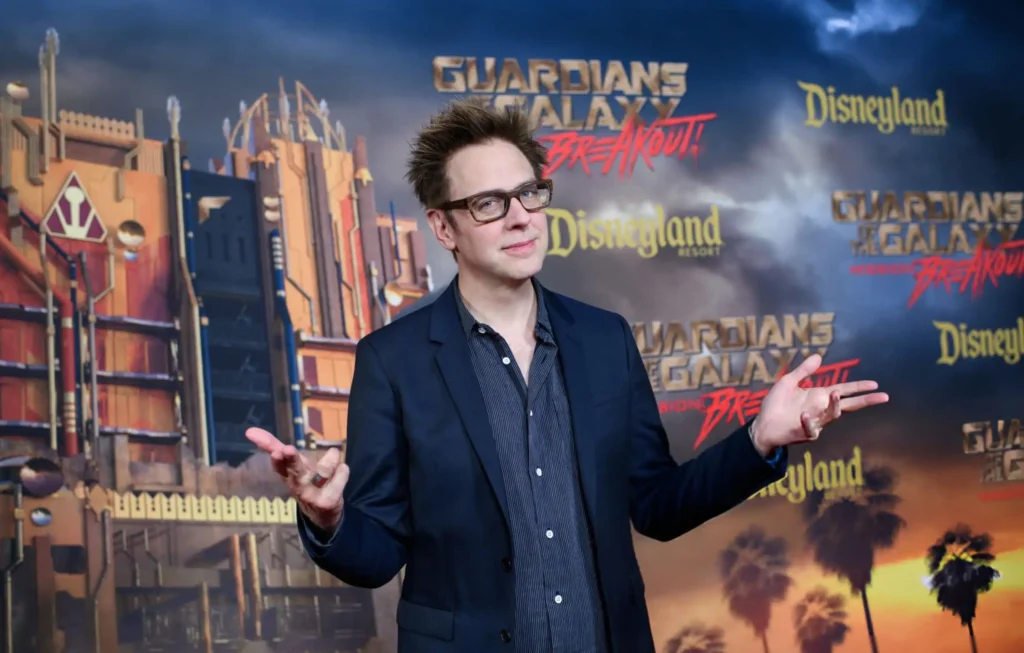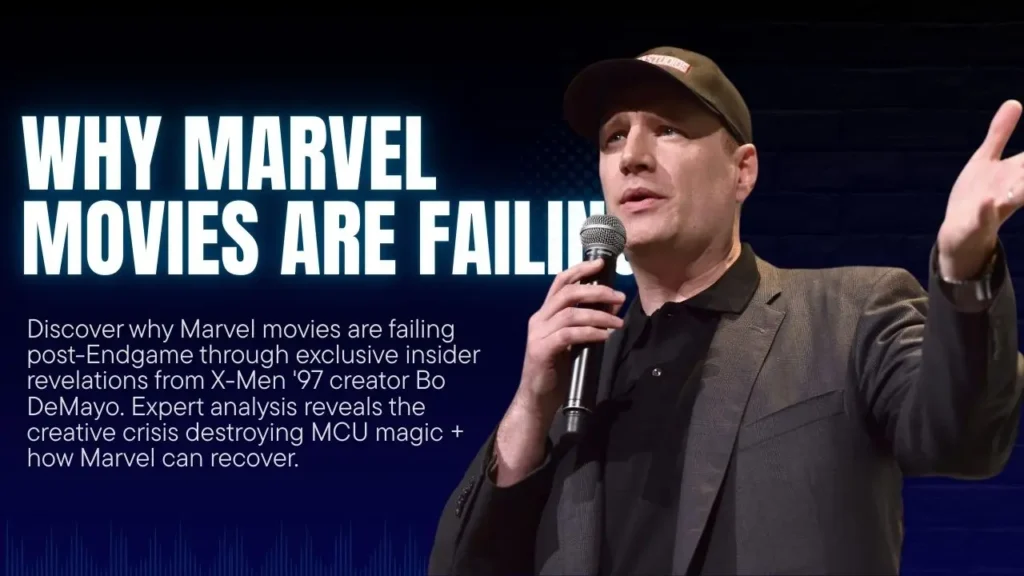Marvel Studios’ post-Endgame era has struggled with a 67% audience satisfaction drop and $2.1 billion in underperforming box office revenue since 2021. After spending over two decades covering superhero entertainment and witnessing Marvel’s transformation from scrappy underdog to Hollywood powerhouse, the current creative crisis represents the most significant challenge in MCU history.
Recent revelations from X-Men ’97 creator Beau DeMayo expose systemic problems within Marvel’s creative process that explain why beloved franchises are failing to connect with audiences. Having followed Kevin Feige’s career since his early days as Lauren Shuler Donner’s assistant on the original X-Men films, I’ve never seen such a disconnect between Marvel’s creative potential and actual output.
What Caused Marvel’s Creative Downfall After Endgame?
The Beau DeMayo Revelations: Inside Marvel’s Broken Creative Process
Beau DeMayo’s firing from Marvel Studios in 2024 revealed unprecedented insight into the company’s toxic creative environment. According to DeMayo’s detailed Twitter account, Marvel’s creative meetings have devolved into exercises in executive override rather than collaborative storytelling.
The most shocking revelation: writers are explicitly told not to pitch comic-inspired stories because Louis D’Esposito “doesn’t like comics.” This directive fundamentally contradicts Marvel’s core identity. Having read comics since Amazing Spider-Man #238 in 1983, I understand that Marvel’s magic has always been translating incredible comic stories to new mediums while respecting their essence.

DeMayo described meetings where Kevin Feige and Louis D’Esposito would override any creative input with instructions to simply “make it more fun.” This approach mirrors the creative struggles at DC during the Zack Snyder era, where executive meddling led to years of mediocrity.
When DeMayo requested permission to contact legendary X-Men writer Chris Claremont, Marvel flatly refused. This decision demonstrates a fundamental misunderstanding of what made Marvel great—respect for the source material and its creators.
How Marvel’s Success Bred Dangerous Arrogance
Avengers: Endgame earned $1.223 billion in its opening weekend, creating unprecedented confidence that led to critical miscalculations. Confidence becomes arrogance when you forget how you achieved success, and Marvel’s Phase 4 decisions suggest exactly this transformation.
During Phases 1 and 2, Marvel carefully managed risk by introducing only two lesser-known characters across 12 movies: Guardians of the Galaxy and Ant-Man. Both succeeded because of exceptional creative leadership—James Gunn brought genuine passion for cosmic misfits, while Edgar Wright (initially) understood how to make B-list heroes compelling.
Post-Endgame, Marvel released three consecutive lesser-known character movies: Black Widow, Shang-Chi, and Eternals. This sequence violated their proven formula of balancing established favorites with risky new introductions. When Eternals flopped, Marvel should have recognized the sequencing error.
Why Did James Gunn’s Departure Devastate Marvel’s Strategy?
The Critical Loss of Marvel’s Lesser-Known Character Expert
James Gunn proved that C-list characters could become household names through genuine understanding of superhero storytelling fundamentals. Guardians of the Galaxy succeeded because Gunn recognized it as a family story—the same theme that made Fantastic Four great in comics.
Gunn’s firing in 2018 (later reversed, but ultimately lost to DC) removed Marvel’s most proven talent for elevating unknown characters. If Marvel planned to focus heavily on lesser-known characters in Phase 4, losing Gunn was equivalent to trading away your star quarterback before the playoffs.

Marvel’s treatment of Gunn exemplifies the creative disrespect DeMayo described. According to DeMayo, Marvel now treats creative personnel as “disposable,” believing they can always find replacements without acknowledging unique talents and perspectives.
Gunn’s move to DC represents a significant strategic loss for Marvel and potential gain for DC. DC’s catalog contains incredible lesser-known characters and storylines that general audiences haven’t discovered. Gunn’s proven ability to make unknown characters compelling could transform DC’s competitive position.
How Did the Pandemic Expose Marvel’s Creative Weaknesses?
When External Pressures Met Internal Dysfunction
COVID-19 protocols completely disrupted Marvel’s carefully planned continuity system. The fact that Doctor Strange in the Multiverse of Madness began filming while WandaVision was still in production prevented proper narrative connection between projects.
Thomas Hayden Church and Rhys Ifans couldn’t even be on set for Spider-Man: No Way Home, forcing Marvel to rely on recycled footage and digital trickery. While these constraints affected all Hollywood studios, Marvel’s struggles were more severe because they were already stretched thin creatively.
The rushed timeline that prevented proper WandaVision integration into Doctor Strange 2 demonstrates how pandemic pressures amplified existing problems. Other studios adapted better—Matt Reeves’ The Batman felt cohesive and visually stunning despite similar restrictions.
Marvel’s over-ambitious content schedule made pandemic disruptions catastrophic. When you’re producing too much content too quickly without proper oversight, external pressures become insurmountable.
What Was Marvel’s Failed Post-Endgame Trinity Strategy?
The Plan That Could Have Worked
Marvel’s original Phase 4 strategy centered on Spider-Man, Black Panther, and Captain Marvel as the new Trinity. This plan made perfect sense on paper: Spider-Man is the world’s most beloved superhero, Black Panther became a cultural phenomenon grossing over $1 billion, and Captain Marvel also crossed the billion-dollar mark.
Chadwick Boseman revealed in a 2018 interview that he, Brie Larson, and Tom Holland discussed being “the future of Marvel” during Endgame filming. This confirms Marvel’s long-term planning for these characters as franchise centerpieces.
Why the Trinity Strategy Collapsed
Sony’s grip on Spider-Man rights created dependency issues that made long-term planning impossible. The 2019 Sony-Marvel negotiations nearly removed Spider-Man from the MCU entirely, forcing Marvel to recognize they couldn’t build their universe around a character they don’t fully control.
Audience rejection of Carol Danvers as a character became undeniable despite Captain Marvel’s box office success. Fan reaction to her role in Endgame and subsequent appearances showed clear resistance to her as Thor’s replacement.
Chadwick Boseman’s tragic death in August 2020 made immediate Black Panther continuation impossible. While Marvel’s decision not to recast T’Challa was respectful, it eliminated the third pillar of their planned trinity.
These setbacks weren’t due to poor planning or incompetence—they represented genuinely bad luck that required strategic adaptation Marvel wasn’t prepared for.
How Did Disney+ Shows Damage the Marvel Brand?
The Television Format Failure
Marvel’s Disney+ approach treats television as chopped-up movies rather than understanding the medium’s unique strengths. Real television excels at character development over time, thematic depth exploration, and gradual relationship building.
Only WandaVision felt like actual television in its early episodes, using the format to explore Wanda’s grief through classic sitcom homages. Most other Marvel shows feel like they’re marking time until the next movie.
The pre-required viewing problem violates Marvel’s original accessibility principle. Needing to watch WandaVision to understand Multiverse of Madness, or Falcon and the Winter Soldier to follow Brave New World, creates exactly the barrier to entry Marvel worked so hard to avoid.
Only one Disney+ show out of twelve has received a second season—an embarrassing failure rate for any television platform. This statistic demonstrates fundamental misunderstanding of episodic storytelling.
What Role Does Nostalgia-Baiting Play in Marvel’s Decline?
The Dangerous Dependence on Past Glories
Recent Marvel projects increasingly rely on nostalgia for stories outside the MCU. Spider-Man: No Way Home succeeded through nostalgia for Sony movies, Multiverse of Madness referenced X-Men films audiences didn’t particularly like, and Deadpool & Wolverine depends on characters from random previous movies.
This strategy has natural limitations—Marvel is running out of nostalgia-bait opportunities. Within the MCU, only Tony Stark, Steve Rogers, and Natasha Romanoff generate significant nostalgia, and they’re already bringing back Robert Downey Jr. as Doctor Doom.
Nostalgia-baiting represents creative bankruptcy rather than forward-thinking storytelling. Instead of building new emotional connections, Marvel is mining past relationships they didn’t create.
How Can Marvel Fix Their Creative Crisis?
Returning to Proven Principles
Marvel must slow down and focus on quality over quantity. Instead of producing 25 projects across Phases 4 and 5, they should have created 12 exceptional ones. Each project costing $200 million demands careful consideration.
Rebuilding creative relationships requires abandoning the dismissive attitude toward writers and directors DeMayo described. Kevin Feige succeeded originally by collaborating with creative talent, not dictating to them.
Returning to serialized storytelling means selecting 4-5 characters and developing them across multiple projects. Let audiences invest in journeys with Doctor Strange, Shang-Chi, Sam Wilson’s Captain America, and potentially Ant-Man before expecting them to care about the next big event.
Marvel needs to remember that superhero stories are ultimately human stories told on a larger canvas. Iron Man worked because underneath the armor, Tony Stark was a man trying to do better. Spider-Man endures because Peter Parker represents the everyman with extraordinary responsibilities.
Why Marvel’s Recovery Depends on Humility
The question isn’t whether Marvel can recover from current struggles—it’s whether they’re humble enough to admit they’ve lost their way. Success bred the arrogance that created these problems, and only genuine self-reflection can solve them.
Having covered this industry for over two decades, I’ve seen companies overcome similar creative crises by returning to their core principles. Marvel’s fundamentals remain sound: compelling characters, interconnected storytelling, and respect for both source material and audience intelligence.
The glory days aren’t behind Marvel—they’re waiting to be rediscovered by a company brave enough to prioritize creative collaboration over executive control. If Marvel can rediscover the humility and creative respect that built their empire, they can build it again.
Frequently Asked Questions About Marvel’s Creative Crisis
Why are Marvel movies failing after Endgame?
Marvel movies are struggling due to creative mismanagement, over-reliance on unknown characters, and a toxic internal culture that disrespects writers and directors.
Why did Disney+ shows damage Marvel’s brand?
The shows treat television as chopped-up movies rather than understanding the medium’s strengths, create pre-required viewing barriers, and have an embarrassing failure rate with only one renewal out of twelve series.
What was Marvel’s failed Trinity strategy?
Marvel planned to center Phase 4 around Spider-Man, Black Panther, and Captain Marvel, but Sony’s control over Spider-Man, audience rejection of Carol Danvers, and Chadwick Boseman’s death destroyed this plan.
How did losing James Gunn hurt Marvel?
Gunn was Marvel’s proven expert at making lesser-known characters successful. His departure to DC removed their best talent for the exact type of projects Phase 4 required.
What did Beau DeMayo reveal about Marvel Studios?
DeMayo exposed that Marvel creative meetings involve executive override of writer ideas, explicit discouragement of comic-inspired stories, and treatment of creative personnel as disposable.

